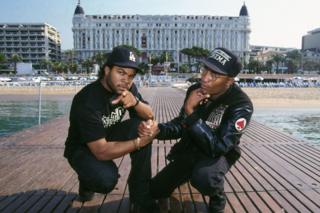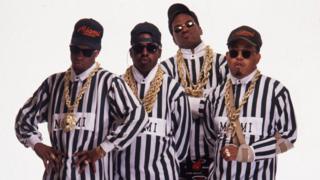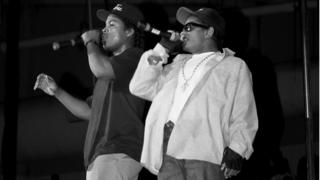Image copyright
Getty Images
John Singleton at the Los Angeles Film Festival in 2011
Few directors have made such an impact with their debut as John Singleton, whose 1991 drama Boyz N The Hood put both him and South Central on the map.
A blistering depiction of growing up in inner-city Los Angeles, the film saw Singleton, then 24, Oscar-nominated for both his direction and screenplay.
Almost three decades on from its Cannes premiere, the film is now regarded as a landmark in contemporary US cinema.
Here are five reasons why it has stood the test of time.
The subject matter
Drawing heavily on his own teenage years, Singleton introduced a largely oblivious world to the harsh urban realities of too many African-American lives.
The story follows Tre, an intelligent young boy who is sent by his single mother to live with his hard-nosed father in the crime-ridden neighbourhood of Crenshaw.
There he grows up alongside childhood friends, half-brothers Ricky – who dreams of playing professional American football – and Doughboy, who seems destined for a life in gangs and drug dealing.
Here was a tableau of casual gunplay, police intimidation and drive-by shootings that left audiences shaken, shocked and deeply moved.
Image copyright
Getty Images
Cuba Gooding Jr. (centre) played Tre as a young man
Years before the Black Lives Matter movement, Boyz N The Hood showed how life in the ghetto had been cheapened by a toxic cocktail of racism, poverty, violence and substance abuse.
Yet Singleton’s film had other concerns to air as well – the insidious threat of gentrification, for example, and the importance of black fathers shouldering their parental responsibilities.
The cast
The fact that Boyz N The Hood’s ensemble features two future Oscar winners – Cuba Gooding Jr. and Regina King – is testament to its director’s eye for emerging talent.
Yet the real coup was casting Ice Cube as belligerent gang member Doughboy, a role that set the former N.W.A. star on the road to celluloid stardom.
 Image copyright
Image copyright
Getty Images
Ice Cube and John Singleton at the 1991 Cannes Film Festival
“He came on board because I wrote the part for him,” Singleton told Vice in 2016. “I couldn’t see anyone else playing that part but Ice Cube.”
The director also had Laurence Fishburne and Angela Bassett play its hero’s estranged parents – foreshadowing their Academy Award-nominated roles as Ike and Tina Turner two years later in What’s Love Got to Do with It.
The music
The authenticity Singleton sought to bring to his film’s story and characters was also a key factor in assembling its chart-topping soundtrack.
Combining West Coast hip-hop from 2 Live Crew and Compton’s Most Wanted with R&B tracks by Hi-Five and Tevin Campbell, the album played a significant role in bolstering the film’s international impact.
 Image copyright
Image copyright
Getty Images
L to R: DJ Mr. Mixx, Fresh Kid Ice, Brother Marquis and Luke Skyywalker of 2 Live Crew
Cube himself contributed How to Survive in South Central, a song whose lyrics were enough in themselves to justify the record’s Parental Advisory sticker:
Now if you’re white you can trust the police / But if you’re black they ain’t nothin but beasts / Watch out for the kill / Don’t make a false move and keep your hands on the steering wheel.
And don’t get smart / Answer all questions, and that’s your first lesson / On stayin’ alive / In South Central, yeah, that’s how you survive.
“I wanted music that people would be playing from their cars and their homes and boomboxes,” Singleton told the Hypebeast website in 2016.
The fashion
For many audience members, the clothes and accessories worn by Ice Cube’s Doughboy, Gooding Jr.’s Tre and Morris Chestnut’s Ricky were stars in the own right.
Boldly coloured patterns, African pendants, snapback hats and two-tone denim were just a few of the looks popularised by Boyz N The Hood, Do the Right Thing and other films of their ilk.
 Image copyright
Image copyright
Getty Images
Ice Cube performing with Eazy-E in 1989
Cube’s own musical past, meanwhile, is referenced by the “We Want Eazy” T-shirt sported by one character – a nod to his N.W.A. bandmate Eazy-E.
According to Grailed, Singleton’s film is a “testament to the ways that early ’90s West Coast street style has become integrated into America’s fashion DNA.”
The spelling
Boyz N The Hood – also the name of an Eazy-E track from 1987 – had another significant if unanticipated legacy: the creative stylisation of film titles.
Gridlock’d, Menace II Society and the N.W.A. biopic Straight Outta Compton are just some of the films to come after it that perhaps owe a debt to its singular typography.
Singleton, who died this week aged 51, even emulated himself in 2003 with 2 Fast 2 Furious, his contribution to the blockbuster Fast and the Furious franchise.

Follow us on Facebook, on Twitter @BBCNewsEnts, or on Instagram at bbcnewsents. If you have a story suggestion email entertainment.news@bbc.co.uk.
